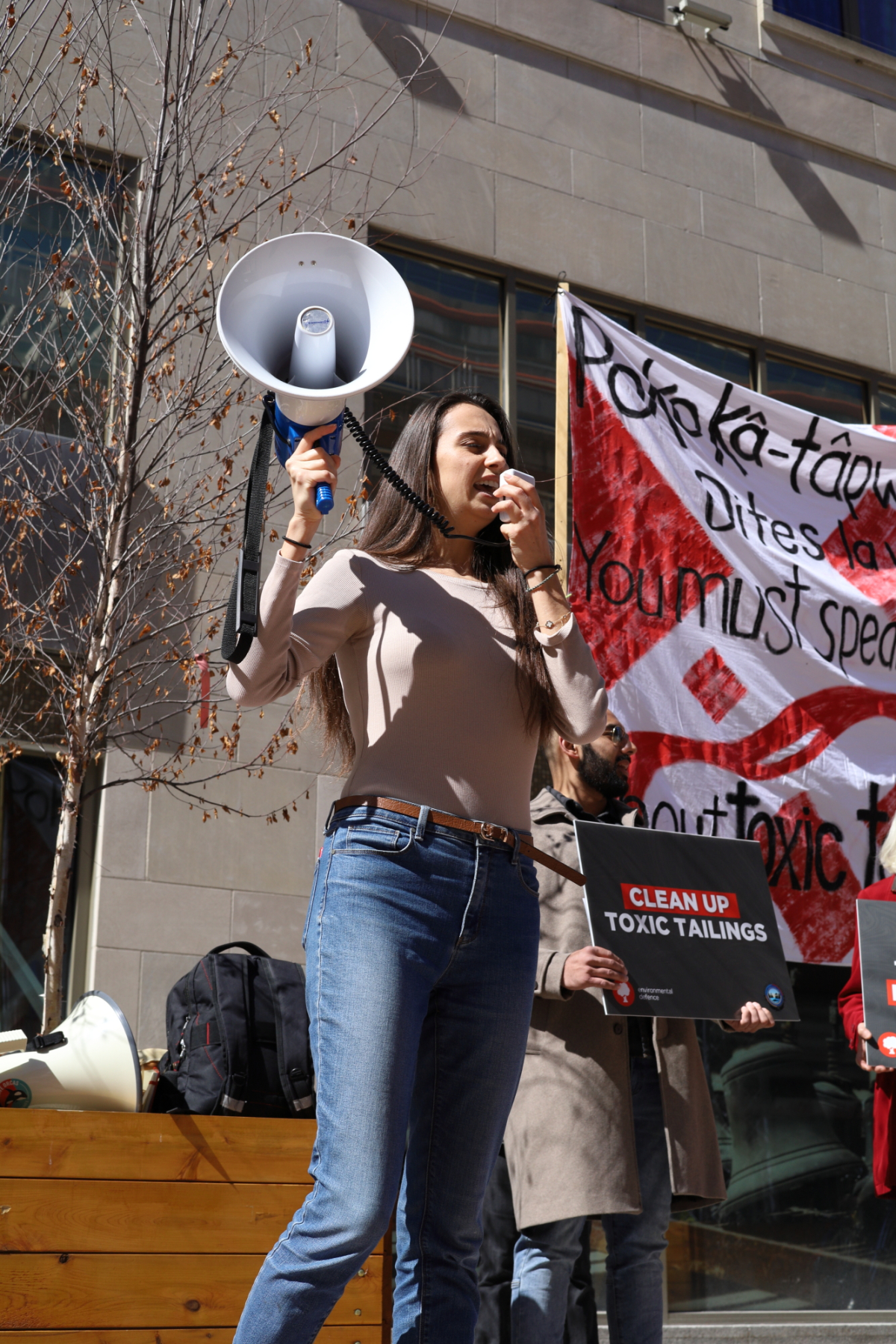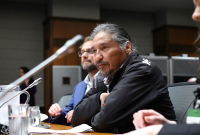Support strong Canadian climate journalism for 2025
Imperial Oil’s president and CEO described the failure to alert downstream communities to toxic oilsands tailings leaks as a “communication breakdown” during his testimony on Parliament Hill on Thursday.
Brad Corson and two other Imperial Oil executives appeared as witnesses at the Standing Committee on Environment and Sustainable Development three days after First Nation, Cree and Métis leaders told committee members how the leaks and lack of communication impacted their communities in northern Alberta, calling for the Alberta Energy Regulator to be dismantled for its failure to protect the public.
This issue has been making international headlines since March after the Athabasca Chipewyan First Nation notified Canadian media that Imperial Oil had failed to tell them and other downstream communities about multiple leaks at its Kearl site for upwards of nine months. It wasn’t until an unrelated 5.3 million litres of tailings spilled from a containment pond in early February 2023 that the Alberta Energy Regulator posted information on both incidents online.
The Kearl situation has shone a light on the looming threat the more than 1.4 trillion litres of oilsands tailings — a mixture containing arsenic, leftover bitumen, toxic naphthenic acids, silt and clay — pose to the people, lands and waters downstream of the oilsands.
Corson repeatedly apologized for failing to provide “sufficient communication” to neighbouring communities.
“We were negligent in not sharing information proactively that we've had. But we've never been trying to hide any information,” he told MPs.
Corson told the committee Imperial Oil is still pumping wastewater into the pond that was found to be seeping wastewater in four different locations.
“The tailings ponds that we use are designed with recognition that some level of seepage could and can occur,” said Corson. Imperial Oil’s senior vice-president of upstream Simon Younger later added that this is “industry standard.”
Thursday’s committee meeting took place against a backdrop of protests demanding Imperial Oil be held accountable for the tailings leak. The night of April 19, environmental activists projected the words “Charge Imperial Oil Now” on the facade of Canada’s Supreme Court. While Imperial Oil testified the following day, activists protested on and around Parliament Hill.

On Monday, Athabasca Chipewyan First Nation Chief Allan Adam told the committee there is potential for legal action against the company, the provincial energy regulator, the province of Alberta and the federal government. By not notifying them about the seepage, Imperial Oil breached its impact benefit agreement with the nation, said Chief Adam.
“We always uphold our side of the agreement and not talk bad about the oilsands operators. We gave you guys that trust that was required for them to operate in our region,” Chief Adam told the committee on Monday.
“All we want here is to be told the truth in regards to what goes on in our region.”
No internal disciplinary action has been taken at Imperial Oil as a direct result of the failures, Fort McMurray-Cold Lake MP Laila Goodridge discovered through her line of questioning. Right now, the focus is on the external incident, said Corson.
Younger, the senior VP of upstream, was also in attendance, along with Helga Shield, manager of environment, regulatory and socioeconomic. To address the seepage, the company drilled 140 wells to monitor water quality and pump water out of those subsurface layers, and took thousands of water samples over the last month, said Corson. The water sampling data was not shared with communities until recently. He reiterated what the company has been saying for weeks: that there were no adverse effects on drinking water or wildlife.
Bloc Québécois MP Kristina Michaud wanted to know why Corson did not communicate directly with chiefs. Corson did not directly answer, instead saying: “We certainly are giving them the information now. We fell short for the period while we were still investigating the situation.”
Corson is currently the best-paid CEO in the Canadian energy industry at $17.3 million in 2022, said NDP MP Heather McPherson, referring to a Globe and Mail article that found his pay nearly doubled last year. The Alberta MP mused that downstream communities might think such high pay is inappropriate.
Later in the meeting, Shields said the seven communities Imperial Oil has agreements with “receive about $16 million a year, collectively.” In 2022, Imperial Oil posted record earnings of $7.34 billion, according to the company’s financial statements.
McPherson then asked how much money has been allocated to clean up the Kearl site after it ceases operations. Corson said he did not have a number available, to which McPherson quipped: “More or less than $17 million?”
While Corson and his executives were testifying, a group of protesters organized by Keepers of the Water and Environmental Defence marched to Parliament Hill from nearby Sparks Street, chanting for Imperial Oil to be held accountable for the massive leak.

“We need Canadians to care about Indigenous communities downstream from Imperial's toxic tailing breach, as much as they did about the ducks,” Keepers of the Water communications manager Tori Cress told Canada’s National Observer. “It's human lives, so we're here to hold Imperial accountable.”
Cress said the federal government should use the Fisheries Act to protect the waterways in Alberta from oilsands industrial wastewater, calling it the only tool left to Indigenous people and settler Canadians alike.
“The first people to feel the effects of climate change are Indigenous communities because we've been forced onto these postage-sized reservations in which, at that time, was land that was unwanted,” she said.
Now, as millions of litres of tailings are known to have leaked into the environment, Cress said it is urgent for the federal government to support an independent health study for downstream communities. First Nations, Métis and Cree leaders also called for cumulative health studies during their testimony on Monday. Already, evidence shows tailings are leaching into groundwater.
Environmental Defence program manager for climate and energy Aliénor Rougeot said Thursday’s rally calling for accountability for Imperial Oil’s leak was aimed at showing federal politicians that it’s not just downstream communities who care about this issue.
“Canadians don't stand for what's happening in the tarsands,” she said. “We do want Canada to intervene, we do want Imperial Oil to be held accountable.”

As the Imperial Oil tailings leak captures the attention of climate watchers, on Wednesday, Suncor reported six million litres of water from a collection pond in Fort Hills was released with higher than allowed levels of suspended solids. Suspended solids refers to anything that could end up in runoff from the surrounding area, including but not limited to sand, sediment and organic matter, according to the Alberta Energy Regulator.
This particular pond collects runoff water from the area, which is then deposited into Fort Creek about 800 metres upstream of the Athabasca River, according to an emailed statement from Teresa Broughton, part of the Alberta Energy Regulator’s media team.
“We want to stress, this was not a leak from a tailings pond, and the water that was released is not processed water from tailings, it is drainage from surrounding landscape,” reads the statement to Canada’s National Observer. It adds that Suncor has stopped the release until the amount of suspended solids is below levels required by the regulator and took water quality samples, the results of which will be shared when available.
Rougeot said sediment being released into the Athabasca River is less concerning than industrial wastewater leaking, but Suncor admitting it had discharged sediment into the river that went beyond what is permitted shows a disturbing pattern because many environmental concerns come from the cumulative impacts on the environment. Even if the exact harm is not known yet, the regulations are there for a reason, she said.
“You don't pour mud in an aquarium and hope your fish is OK. It's the same kind of scenario; there's a reason there's guidelines,” she said.
This latest issue and the ongoing situation at Exxon-Imperial’s Kearl site has drawn attention to the fact there is “a systemic problem with the management and structural integrity of tailings ponds across the whole region, and a regulator that refuses to regulate,” the ACFN said in a statement released April 19.
Corson, Younger and Shield refused to answer questions from reporters on the way out of the committee meeting.
Natasha Bulowski & John Woodside / Local Journalism Initiative / Canada’s National Observer







Comments
Imperial Oil should be charged. I doubt very much this was an oversight to report the discharge, it was deliberate to hide the leak. There are too many people involved to not suggest "hey, did anyone report this?".
But because the politicians are in bed with oil and gas, nothing will be done. I am glad I don't live in Alberta, the corruption by oil and gas and the UCP is just criminal.
Elizabeth May, as usual, asked the most trenchant question, to the effect of: You talked over and over of a failure of communication. Wouldn't you say you had a pollution problem, not a communication problem?
What a lying sack of tailings.